Vatikanstadt |
|
|
|
| Übersicht – Contents: | |
Vatikanstadt |
|
|
|
| Übersicht – Contents: | |
Flagge – Flag: |
|
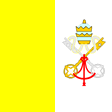 |
seit/
since 1929, Flagge des Vatikans – Flag of the Vatican, Seitenverhältnis – ratio = 1:1, Quelle/Source: nach/by: Wikipedia (D) |
historische Flaggen – historical Flags: |
|
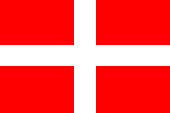 |
12. bis/to 15. Jhd./cent., |
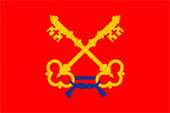 |
17. Jhd./cent. bis/till 1798,
1800–1803, |
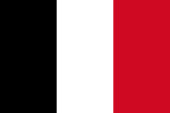 |
1798-1799, Flagge der Römischen Republik – flag of the Roman Republic, Quelle/Source: nach/by: World Statesmen |
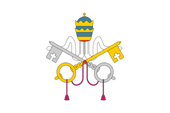 |
1803–1809, |
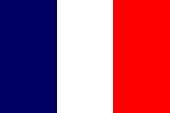 |
1809–1814, der Kirchenstaat gehört zu Frankreich – the Papal State belongs to France |
 |
1814–1829, |
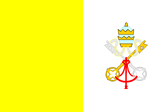 |
1829–1870, |
 |
Flagge der Katholischen Kirche – flag of the Catholic Church |
Bedeutung/Ursprung der Flagge – Meaning/Origin of the Flag: |
|
| Die heutige Flagge des Vatikan wurde am 08.07.1929 offiziell eingeführt. Sie ist quadratisch und zeigt zwei senkrechte Streifen in Gelb und Weiß. In der Mitte des weißen Streifens sind die seit dem 13. Jahrhundert verwendeten päpstlichen Symbole zu sehen: die Krone des Papstes (Tiara) und zwei gekreuzte Schlüssel (Schlüssel Petri). Gelb (Gold) und Weiß (Silber) wurden von Papst Pius VII. im Jahre 1808 als neue päpstliche Farben eingeführt und ab 1829 auch auf der Flagge verwendet. Sie ersetzten das bis dahin übliche Rot und beziehen sich auf die beiden Schlüssel aus dem Wappen, einer ist silbern und einer golden. Sie stehen für Binden und Lösen. Die rote Kordel zwischen den Schlüsseln symbolisiert das gemeinsame Wirken beide Mächte. | The
today's flag of Vatican City was officially introduced on 8th of July in
1929. It is square and shows two vertical stripes of yellow and white. In the middle of the white stripe are to see since the 13th century the papal symbols: the crown of the pope (Tiara) and two crossed keys (keys of Peter).
Yellow (gold) and white (silver) were introduced by Pope Pius VII. in 1808
as the new papal colours, they were used on flags from 1829 too. They
replaced theby then usual red and refer to the two keys from the coat of
arms. One is a silver and one is gold. They stand for binding and loosing.
|
| Jeder Papst hat seine persönliche Flagge. Sie ist weiß und zeigt sein eigenes Wappen in der Mitte, eine Kombination aus päpstlichen Motiven und seinem Familienwappen. | Each pope has his own personal flag. It is white and shows his own coat of arms in the middle, a combination of papal motives, and the coat of arms of his family. |
| Die Flagge der Vatikanstadt wird auch zur See benutzt und auch auf den Besitzungen des Vatikans außerhalb des eigentlichen Staatsgebiets gehisst, z.B. Castel Gandolfo. | The flag of Vatican City is also used at sea, and hoisted on the estates of the Vatican outside the actual territory, e.g. Castel Gandolfo. |
| Die heutige Flagge geht auf ein älteres Modell zurück, das zwischen 1829 und 1870 verwendet wurde, damals offiziel rechteckig, heute offiziell quadratisch. In der Praxis werden jedoch häufig rechteckige Flaggen verwendet. | The
today's flag dates back to an older model that was used from 1829 to 1870,
then officially rectangular, today officially square. In practice, however, are often used rectangular flags. |
| Bis 1808 war Rot die Farbe des Vatikans, und die päpstlichen Symbole wurden auf roten Flaggen verwendet. Im Mittelalter und noch in der Zeit der Renaissance wurden rote Flaggen mit einem durchgehenden weißen Kreuz verwendet. Diese waren Vorbild für viele noch heute gebräuchliche Kreuzflaggen (z.B. Dänemark), die oft durch Päpste verliehen wurden. Der Johanniterorden verwendet noch heute die päpstliche Flagge des Mittelalters. | Before
1808 red was the color of the Vatican and the papal symbols have been used
on red flags. In the Middle Ages and even into the Renaissance era red flags
have been used with a continuous white cross. That was the model for many flags, which are still in use until today (e.g. Denmark), which were often granted by the popes. The Order of St. John still uses today, the papal flag of the middle ages. |
| Quelle/Source: Flags of the World, Die Welt der Flaggen, Wappen und Flaggen aller Nationen, Flaggen Wappen Hymnen, Flaggen und Wappen der Welt | |
Wappen – Coat of Arms: |
|
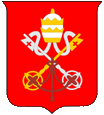 |
Wappen der Vatikanstadt – coat of arms of Vatican City State, Quelle/Source: nach/by: Wikipedia (D) |
Bedeutung/Ursprung des Wappens – Meaning/Origin of the Coat of Arms: |
|
| Das Staatswappen wurde in seiner heutigen Form im Grundgesetz des Vatikans vom 07.06.1929 festgelegt. Es zeigt in einem rotem Schild die seit dem 13. Jahrhundert verwendeten päpstlichen Symbole: die Krone des Papstes (Tiara) und zwei gekreuzte Schlüssel. Es sind die Schlüssel Petri. Sie stehen für Binden und Lösen. Die rote Kordel zwischen den Schlüsseln symbolisiert das gemeinsame Wirken beide Mächte. Rot ist die traditionelle päpstliche Farbe. Das Wappen war schon vor 1929 in Verwendung. Es ging aus dem Wappen von Papst Martin V. (1417–1431) hervor. Jeder Papst hat sein eigenes persönliches Wappen, eine Kombination aus päpstlichen Motiven und seinem Familienwappen. | The coat
of arms was adopted in its present form with the Basic Law of the Vatican
from 7th of June in 1929. It shows within a red shield the since the 13th
century usual papal symbols: the crown of the pope (Tiara) and two crossed keys. These are the keys of Peter. They stand for binding and loosing. The red cord between the keys symbolizes the joint work of both powers. Red is the traditional papal color. The emblem was in use already before 1929. It emerged from the arms of Pope Martin V. (1417–1431). Every pope has his own personal coat of arms, a combination of papal motives, and the coat of arms of his family. |
| Quelle/Source: Die Welt der Flaggen, Wappen und Flaggen aller Nationen, Flaggen Wappen Hymnen, Flaggen und Wappen der Welt | |
Landkarte – Map: |
|
| Historische Staaten in Italien – Historical states in
Italy: ca. 1850–1858 alle Staatsbezeichnungen in Englisch – all state denominations in English |
|
| Landkarte/Map: Volker Preuß |
Zahlen und Fakten – Numbers and Facts: |
|
|
|
|
|
|
|
|
|
|
|
|
|
|
|
Geschichte: |
|
ca. 60 n.Chr.
· der Apostel Petrus gründet in Rom die Römische Kirche ab. 4. Jahrhundert · durch Schenkungen erwirbt die Römische Kirche Grundbesitz, neben der Stadt Rom weitere Gebiete in Italien 536–568 · bis auf das Dukat von Rom gehen alle Besitzungen durch die Eroberungen des Byzantinischen Reiches und der Langobarden verloren 754 · Pippinsche Schenkung, der fränkische König Pippin der Jüngere übergibt Papst Stephan II. einige von den Langobarden eroberte Gebiete in Italien, einschließlich der Stadt Rom (Dukat von Rom), Gründung des Kirchenstaates (Patrimonium Petri) 756 · Pippin erweitert die Schenkung um das Exarchat Ravenna und die Pentapolis (5 Städte an der Adria) 899–950 · Ungarneinfälle 11. Jahrhundert · das Exarchat Ravenna und die Pentapolis kommen vorübergehend an das Königreich Italien 1201 und 1213 · das Exarchat Ravenna und die Pentapolis kommen wieder an den Kirchenstaat 1309–1377 · die Päpste residieren in der Stadt Avignon in Venaissin (Frankreich) 1512 und 1598 · die Herzogtümer Parma, Modena und Ferrara kommen vorübergehend an den Kirchenstaat 1796 · Italienfeldzug Napoléons 1798 · französische Truppen Napoléons marschieren in Rom ein, der Papst geht nach Valence in Frankreich, der Kirchenstaat (Patrimonium Petri) wird "Römische Republik" 1799 · Abzug der französischen Truppen, Einmarsch von Truppen des Königreichs Neapel, Ende der Römischen Republik 1801 · Konkordat mit Frankreich zur Wiederherstellung des Kirchenstaats 1809 · Napoléon annektiert den Kirchenstaat 1813 · Konkordat mit Frankreich, offizielle Abschaffung des Kirchenstaats 1814 · Niederlage des Napoléonischen Frankreich, Rückkehr des Papstes nach Rom 1815 · Wiener Kongress, Wiederherstellung des Kirchenstaats 1860 · Umbrien, Marken and die Romagna werden von Sardinien-Piemont annektiert 1870 · der Kirchenstaat wird von Italien annektiert 07.06.1929 · Lateranverträge, Wiederherstellung des Kichenstaats als Kleinstaat innerhalb der Stadt Rom (Vatikanstadt) 06.04.1964 · Vatikanstadt wird ständiger Beobachter in der UNO |
History: |
|
about 60 A.D.
· The apostle Peter founds in Rome the Roman Church since 4th century · by donations the Roman Church acquires properties, next to the city of Rome other areas in Italy 536–568 · except the Dukat of Rome, all possessions get lost by the conquest of the Byzantine Empire and the Lombards 754 · donation of Pippin, the Frankish King Pippin the Short hands over to the Pope Stephen II, some frome the Lombards conquered territories in Italy, including the city of Rome (Dukat of Rome), founding of the Papal States (Patrimony of St. Peter) 756 · Pippin extends the donation by the Exarchate of Ravenna and the Pentapolis (5 cities on the Adriatic Sea) 899–950 · Hungarians invasions 11th century · the Exarchate of Ravenna and the Pentapolis come temporarily to the Kingdom of Italy 1201 and 1213 · the Exarchate of Ravenna and the Pentapolis come back to the Papal States 1309–1377 · the popes reside in the city of Avignon in Venaissin (France) 1512 and 1598 · the duchies of Parma, Modena and Ferrara come temporarily to the Papal States 1796 · Italy Campaign of Napoléon 1798 · French troops of Napoléon marched into Rome, the Pope goes to Valence in France, the Papal States (Patrimonium Petri) become the "Roman Republic" 1799 · withdrawal of the French troops, invasion of troops from the Kingdom of Naples, the "Roman Republic" ends 1801 · concordat with France, restore of the Papal States 1809 · Napoléon annexes the Papal States 1813 · concordat with France, official abolition of the Papal States 1814 · defeat of Napoléonic France, the pope returnes to Rome 1815 · Congress of Vienna, restore of the Papal States 1860 · Umbria, Marches and the Romagna become annexed by Sardinia-Piedmont 1870 · the Papal State become annexed by Italy 7th of June 1929 · Lateran Treaty, restoration of the Papal States as a small state within the city of Rome (Vatican City) 6th of April 1964 · Vatican Cityis a permanent observer at the UN |
| Quelle/Source: Meyers Konversationslexikon, Atlas zur Geschichte, 1.) Wikipedia (D), 2.) Wikipedia (D) |
Ursprung des Landesnamens – Origin of the Country's Name: |
|
| Die heutige "Vatikanstadt" setzt die Tradition des "Kirchenstaats" fort. Offiziell heißt dieses Land "Staat der Vatikanstadt", auf Latein "Status Civitatis Vaticanæ", auf Italienisch "Stato della Città del Vaticano". Weitere Namen sind "Sancta Sedes", zu Deutsch "Heiliger Stuhl" und "Patrimonium Petri", der "Nachlass des Petrus". | Today's
"Vatican City" continues the tradition of the "Papal States". Officially
this land is called "State of Vatican City", in Latin "Status Civitatis
Vaticanæ", in Italian "Stato della Città del Vaticano". Other names are
"Sancta Sedes", what means "Holy See" and "Patrimonium Petri" the "Estate of
Peter." |
| Quelle/Source: Wikipedia (D) | |
| heutige Regionen Italiens – today's regions of Italy: alle Bezeichnungen in Italienisch – all denominations in Italian |
|
| Landkarte/Map: Volker Preuß |